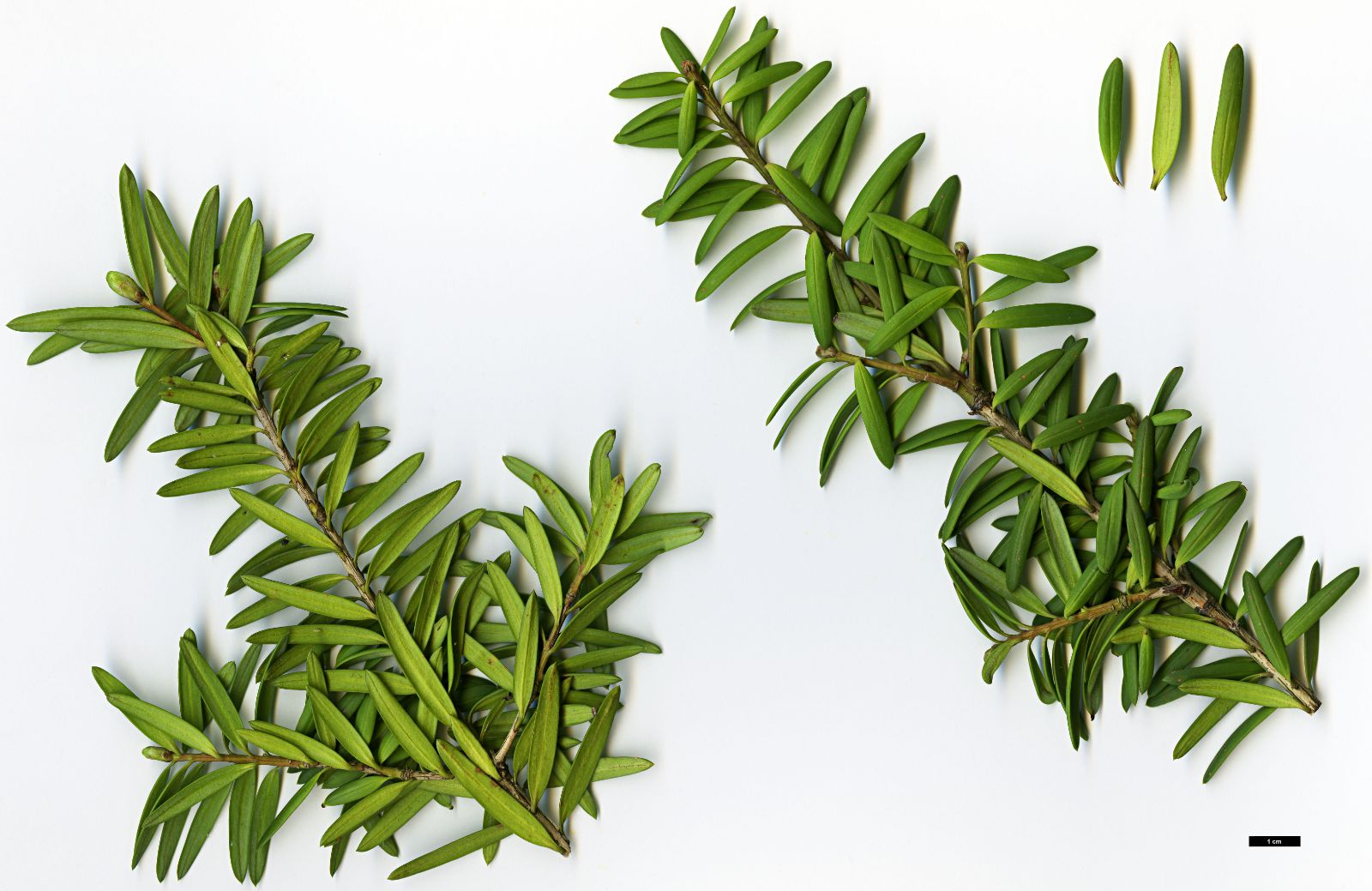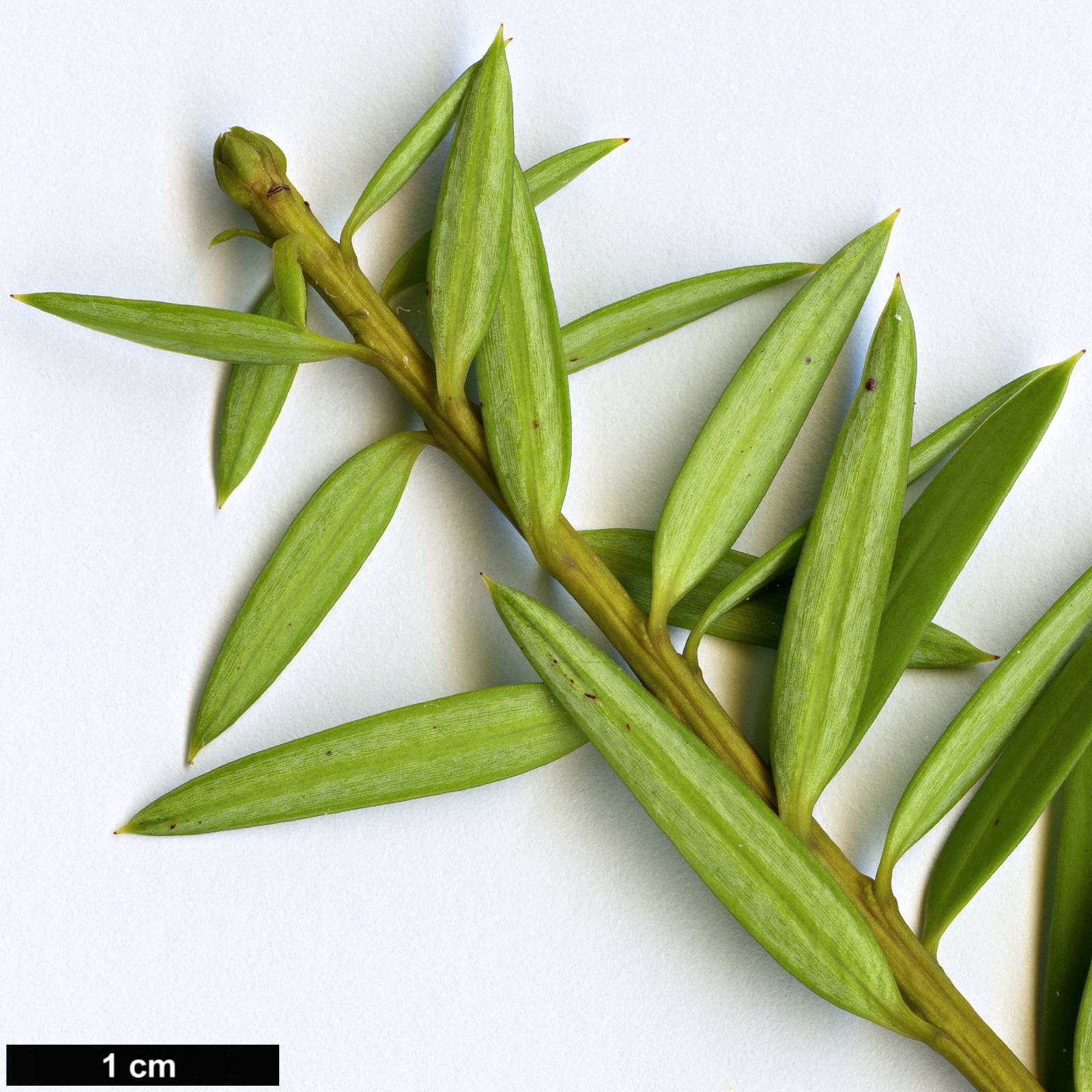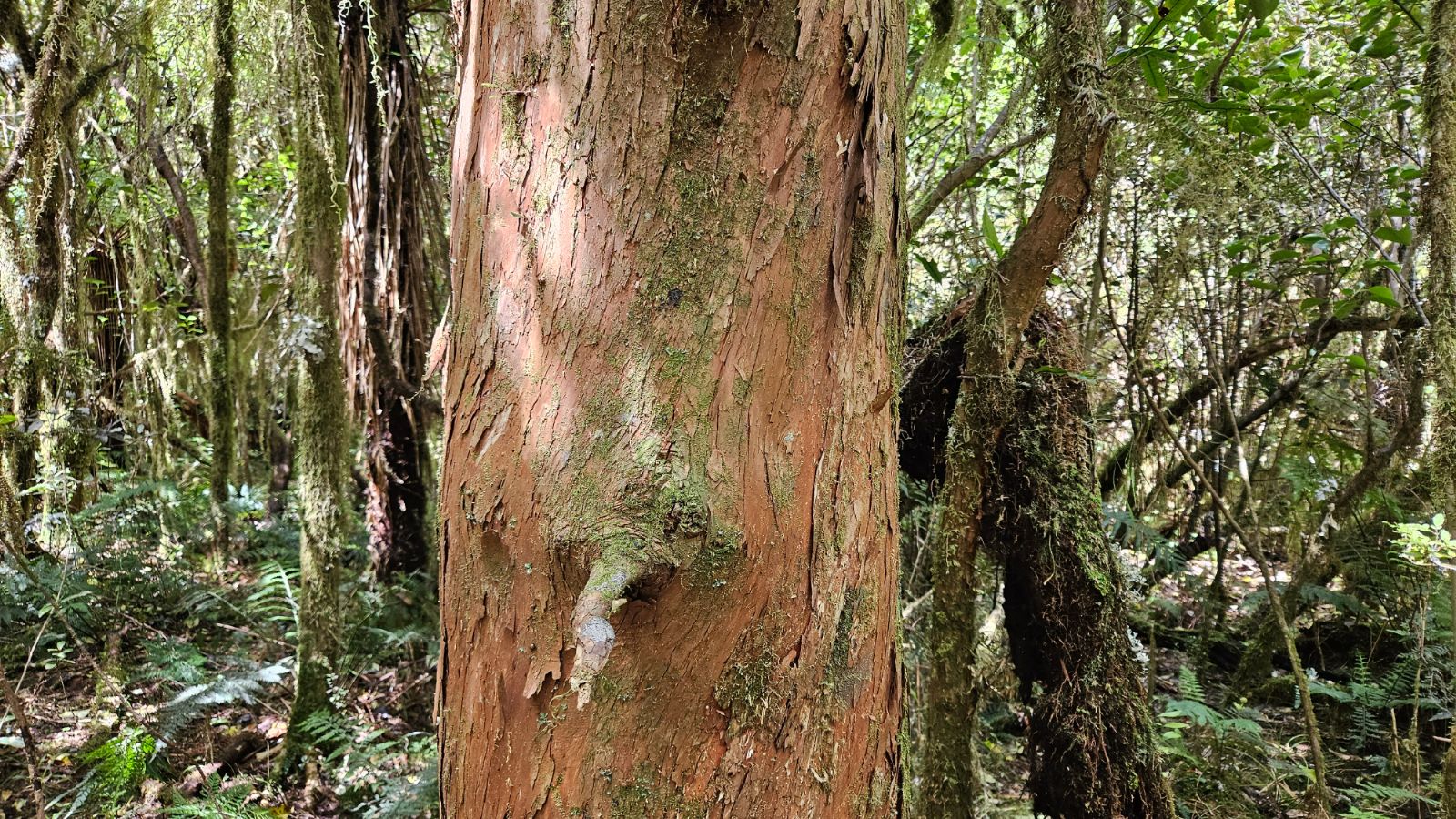Podocarpus laetus
Sponsor
Kindly sponsored by
The British Conifer Society in memory of Derek Spicer VMM, founder member.
Credits
Tom Christian (2023)
Recommended citation
Christian, T. (2023), 'Podocarpus laetus' from the website Trees and Shrubs Online (treesandshrubsonline.
Genus
Common Names
- Hall's Totara
- Montane Totara
- Thin-barked Totara
- Tōtara-kiri-kōtukutuku
Synonyms
- Nageia hallii (Kirk) Kuntze
- Nageia laeta (Hooibr. ex Endl.) Kuntze
- Podocarpus hallii Kirk
- Podocarpus cunninghamii Colenso
- Podocarpus totara var. hallii (Kirk) Pilger
Other taxa in genus
- Podocarpus acutifolius
- Podocarpus acutifolius × lawrencei
- Podocarpus acutifolius × nivalis
- Podocarpus acutifolius × totara
- Podocarpus brassii
- Podocarpus costalis
- Podocarpus drouynianus
- Podocarpus elatus
- Podocarpus elongatus
- Podocarpus guatemalensis
- Podocarpus henkelii
- Podocarpus laetus × nivalis
- Podocarpus lambertii
- Podocarpus latifolius
- Podocarpus lawrencei
- Podocarpus lawrencei × nivalis
- Podocarpus macrophyllus
- Podocarpus matudae
- Podocarpus milanjianus
- Podocarpus nakaii
- Podocarpus neriifolius
- Podocarpus nivalis
- Podocarpus nubigenus
- Podocarpus oleifolius
- Podocarpus parlatorei
- Podocarpus pilgeri
- Podocarpus pseudobracteatus
- Podocarpus salignus
- Podocarpus spinulosus
- Podocarpus totara
Tree to 20 m × 1–1.6 m dbh, monopodial. Bark thin, scaly, reddish-brown, freely flaking. Branches erect at first, later spreading; crown rounded, dense. Branchlets finely grooved, glabrous, branching irregularly when young. Terminal buds small, though distinctly wider than the diameter of the shoot, subglobose, with acute or rounded imbricate scales. Leaves lanceolate to linear-lanceolate, 1.5–3.5 × 0.3–0.65 cm on established trees (2.5–5 × 0.4–0.5 cm on saplings and young trees), linear to slightly curved, leathery, base gradually tapering, twisted, short-petiolate to sessile to short-decumbent, apex acute-pungent, mid-green above with midrib a narrow groove, pale green below with two faint stomatal bands either side of obtuse midrib; foliage often with a yellowish or brownish hue. Pollen cones solitary or in clusters of 2–5 on a common peduncle, cylindrical, 10–25(–30) × 5–8 mm at maturity, straight or curved after pollen release. Seed cones solitary, short-pedunculate, with two bracts which fuse to become a narrowly oblong, swollen, fleshy receptacle 4.5–6 × 3.5–4 mm, yellow at first, red to crimson at maturity; seed including the epimatium green to glaucous 3.5–4 × 2–2.5 mm, narrow-ovoid and acute at the apex. (Farjon 2017; de Lange 2022; Clarke 1988; Allan 1961).
Distribution New Zealand North Island, South Island, Stewart Island
Habitat Coniferous and mixed forests from near sea level (in the south) to c. 1000 m asl, but most common in montane forests, typically replacing P. totara above c. 500 m asl.
USDA Hardiness Zone 8-10
RHS Hardiness Rating H4
Conservation status Least concern (LC)
Hall’s Totara, Podocarpus laetus, remains much better known by its two older names P. cunninghamii and P. hallii, one or other of which was in almost constant use from the late nineteenth century up to about 2015, when Molloy (2015) demonstrated that P. laetus is the oldest, validly published name for this tree, and therefore takes priority. Web-based resources such as Plants of the World Online, NZFlora, and The Gymnosperm Database have all updated their taxonomy, but the many printed text books on conifers published in the years up to 2015 (and a few printed after this date) all treat Hall’s Totara under one of these old names, and labels in many living collections are yet to be updated.
P. laetus is very similar to its fellow New Zealand endemic P. totara and is sometimes included within it as a variety (indeed, the various rules that govern botanical nomenclature mean that when Hall’s Totara is treated as a P. totara variety its correct name is P. totara var. hallii (Kirk) Pilg.). Distinguishing these two species, as they are treated here, is difficult. Both in gardens and in the wild P. laetus is generally a smaller tree, but the most reliable means to distinguish them is the bark: thick, furrowed and exfoliating in longitudinal fibrous strips in P. totara; much thinner, smoother, and exfoliating in papery scales or strips in P. laetus. Juvenile plants of P. laetus also have larger, distinctly petiolate leaves with conspicuously decurrent bases, and the shade leaves of adult trees are very similar in these characters (Debreczy & Rácz 2011; Bean 1976). Like all New Zealand podocarps these two species hybridise where their ranges overlap, and intermediate forms are also in cultivation.
Confusion with P. totara means that no precise date can be placed on this species’ introduction to cultivation outside New Zealand; it probably arrived in Britain in the mid-19th century, sometime after 1845. Lowland P. totara would have been more accessilbe to early collectors, and certainly seems to be the more commonly cultivated of the two in the UK and Ireland (Tree Register 2023). Like P. totara the largest P. laetus in Britain also grows at Tregrehan, but in 2014 was only 15 m × 39 cm dbh while the largest P. totara was 24.7 m × 59 cm dbh. Other sizeable trees grow at Kilmacurragh (14 m × 75 cm dbh in 2014), at Castlewellan (13 m × 51 cm and 12 m × 53 cm in 2015) and at Caerhays (12 m × 27 cm in 2016, with the cautionary note ‘perhaps just a spindly P. totara?’) (Tree Register 2023). Wild collected seed has been introduced to the Royal Botanic Garden Edinburgh on several occasions from the 1970s, the resulting plants outsourced to Benmore Botanic Garden in Argyll and Logan Botanic Garden in Wigtownshire, and to several sites in Cornwall (Royal Botanic Garden Edinburgh 2023). An example raised from Page 10596 at Logan, planted c. 1980, was 7 m tall × 19 cm dbh in 2017 (Tree Register 2023) and another from Unwin & Unwin 31, gathered in 2005, was c. 3 m × 9 cm in 2022 (pers. obs.). P. laetus is cultivated in a few specialist collections elsewhere, mainly in the US and Australia and in New Zealand of course, but accounts of individual specimens are scarce.
The etymology of P. laetus is unclear but the New Zealand Plant Conservation Networks suggests that it derives from the latin ‘bright’, a reference to the bright or yellowish-green foliage which they suggest is distinctly paler than in other NZ podocarps (de Lange 2022).
'Cobb'
A shrubby, free-fruiting selection with grey-green leaves raised by Graham Hutchins in the UK, from seed he collected in 1990 in the Cobb Valley on New Zealand’s South Island (Hutchins 1996).
'Kiwi'
According to British nurseryman Graham Hutchins this was for many years ‘the only form cultivated in Britain’ (Hutchins 1996) which could be taken to suggest that somebody named it to distinguish historic material from new introductions in the latter part of the 20th century, but Hutchins provides no evidence for this claim. Given the historic difficulties distinguishing this species from P. totara, a flurry of more recent introductions, and the fact very few trees in collections bear this name, it is probably best consigned to history.
'Roro'
A strong growing male clone with pale green leaves ‘with a distinctly glossy, creamy sheen on [the] upper surface [and] new growth cream to a pinkish-ruby colour’ (Auders & Spicer 2012; whose illustration also shows a ruby-red winter foliage colour). Raised in the UK by Graham Hutchins from seed collected c. 1986 near the Ngaruroro River, Mount Kuripapango, North Island; only a single seed from this collection germinated, later named ‘Roro’ (Hutchins 1996).










